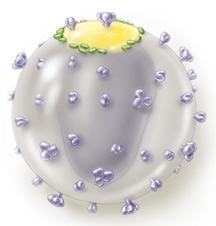Hide-and-Seek: Altered HIV Can't Evade Immune System
 09/26/2011 - Researchers
at Johns Hopkins have modified HIV in a way that makes it no longer
able to suppress the immune system. Their work, they say in a report published online September 19 in the journal Blood,
could remove a major hurdle in HIV vaccine development and lead to new treatments. 09/26/2011 - Researchers
at Johns Hopkins have modified HIV in a way that makes it no longer
able to suppress the immune system. Their work, they say in a report published online September 19 in the journal Blood,
could remove a major hurdle in HIV vaccine development and lead to new treatments.
"Something about the HIV virus turns down the immune response, rather than triggering it, making it a
tough target for vaccine development," says David Graham, Ph.D., assistant professor of molecular and comparative
pathobiology and medicine. "We now seem to have a way to sidestep this barrier," he adds.
Typically, when the body's immune system cells encounter a virus, they send out an alarm by releasing
chemicals called interferons to alert the rest of the body to the presence of a viral infection. When the immune cells encounter
HIV, however, they release too many interferons, become overwhelmed and shut down the subsequent virus-fighting response.
The researchers had learned from other studies that when human immune cells (white blood cells) are
depleted of cholesterol, HIV can no longer infect them. It turns out the coat that surrounds and protects the HIV viral genome
also is rich in cholesterol, leading the Johns Hopkins team to test whether viruses lacking cholesterol could still infect
cells at all.
The researchers treated HIV with a chemical to remove cholesterol from the viral coat. Then they introduced either the
cholesterol-diminished or normal HIV to human immune cells growing in culture dishes, and measured how the cells
responded. The cells exposed to cholesterol-diminished HIV didn't release any initial-response interferons,
whereas the cells exposed to normal HIV did.
"The altered HIV doesn't overwhelm the system and instead triggers the innate immune response to kick in, like it does
with any first virus encounter," says Graham.
Next, the researchers checked to see if cholesterol-diminished HIV activates so-called adaptive immune responses-the
responses that help the body remember specific pathogens long-term so the body develops immunity and counters future
infections. To do this, they put normal HIV or cholesterol-diminished HIV into blood samples, which contain all the
different cells needed for an adaptive immune response.
More specifically, they tested blood samples from people with previous exposure to HIV in order to see if their
blood could mount an adaptive immune response. Blood samples were used from 10 HIV positive people and from 10 people
repeatedly exposed to HIV who weren't infected. The researchers didn't expect the HIV-positive blood to respond to
either version of HIV because of the severely damaged immune systems of HIV patients. However, when
cholesterol-diminished HIV was introduced to the non-infected HIV blood in a tube, the cells of the
adaptive immune response reacted against the virus. By altering the virus, explains Graham, the
researchers were able to reawaken the immune system's response against HIV and negate
HIV's immunosuppressive properties.
"In addition to vaccine applications, this study opens the door to developing drugs that attack the HIV
viral coat as an adjunct therapy to promote immune system detection of the virus," says Graham.
This research was supported by funds from the Wellcome Trust and the National Institutes of Health.
Contributors to the research include David Graham and Veronica Aquino of The Johns Hopkins University; Adriano Boasso,
Caroline Royle and Spyridon Doumazos of Imperial College; Mara Biasin, Luca Piacentini, Barbara Tavano and Mario Clerici of
UniversitÓ degli Studi di Milano; Dietmar Fuchs of Innsbruck Medical University; Francesco Mazzotta and Sergio Lo Caputo
of Ospedale S. M. Annunziata and Gene Shearer of the National Cancer Institute.
###
Related Stories:
Rooting Out Reservoirs of HIV Infection
Acne Drug Prevents HIV Breakout
Robert and Janet Siliciano, both of Medicine,on the prospects of a cure for HIV infection
On the Web:
David Graham: http://www.hopkinsmedicine.org/mcp/faculty/Graham.html
Department of Molecular and Comparative Pathobiology: http://www.hopkinsmedicine.org/mcp/
Blood : http://bloodjournal.hematologylibrary.org/
Media Contacts:
Vanessa McMains; 410-502-9410; vmcmain1@jhmi.edu
Audrey Huang; 410-614-5105; audrey@jhmi.edu
Maryalice Yakutchik; 443-287-2251; myakutc1@jhmi.edu
Source: Johns Hopkins Medicine
|